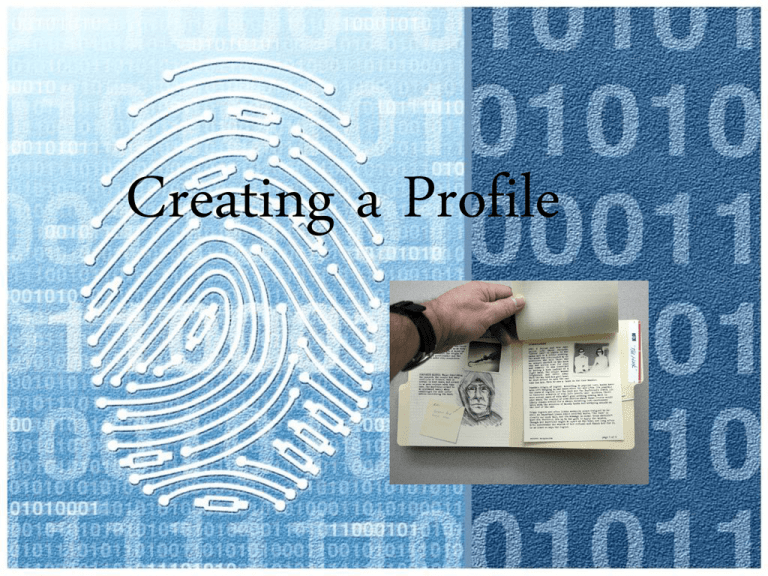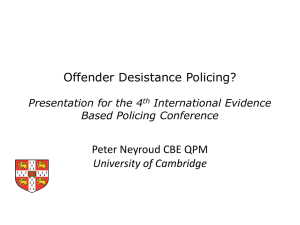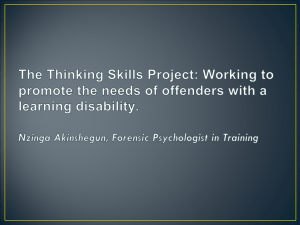op ppt - PE and Me
advertisement

Creating a Profile Top Down Typology Like a Jigsaw See the picture then find the pieces to fit it CANADA USA MEXICO Top – Down Typology Top – Down Typology • • • • • • The American, or ‘top-down’, approach was compiled by the FBI through a series of in-depth interviews with 36 convicted sexually orientated murderers, including Ted Bundy and Charles Manson. This information, along with detailed information from the FBI Behavioural science unit, was combined with detailed examination of the crime scene, the nature of attacks, forensic evidence, and any information relating to the victim to develop models that would result in a profile of the offender. From this the FBI developed a classification system for several serious crimes. Murders (in particular ‘lust murders’) were classified as either ‘organised’ or ‘disorganised’ and a set of characteristics was built from this. Organised offenders would show planning in their crimes, leave few clues, and target a stranger; from this it was possible to infer that they would be above average IQ, be socially and sexually competent and in a skilled occupation. Those categorised as disorganised would show the opposite traits. FBI investigators, Hazelwood & Douglas in 1980 were able to classify crimes in terms of the ‘organised’ and ‘disorganised’ offender by attempting to fit new crimes into these existing categories based on details of the crime and intuitive analysis. Disorganised scene Organised murder scene Planned Victim — targeted stranger Control including restraints, Aggression before death Body hidden or moved from crime scene Weapon and evidence absent Spontaneous Victim — known by offender Little control Sexual acts before death Body not hidden or left at crime scene. Evidence present Organised murderer Disorganised murderer More-than-average lQ Skilled occupation Controlled mood Living with partner Mobile — for example, car Socially competent Sexually competent Inconsistent discipline as child Use of alcohol during crime Follows crime on news Limited change in behaviour after crime Less-than-average IQ Unskilled Uncontrolled Living alone Lives near crime Socially incompetent Sexually incompetent Harsh discipline as child Alcohol not used during crime Does not follow crime on news Major behaviour change after crime FBI The FBI need certain information before they can make the profile • Colour Photos of the crime scene • Data about the neighbourhood of the crime (housing, income) • Medical Examiners report • A map of the victims travels prior to death • A complete investigative report of the incident • Background details of the victim FBI – 4 STAGES 1. 2. 3. 4. DATA ASSIMILATION CRIME CLASSIFICATION CRIME RECONSTRUCTION PROFILE GENERATION http://youtu.be/eSfgY8sr46o Agents Given the evidence provided your task is to draw up a profile of the offender. • Use the the differences between organised and disorganised murders The following exercise is taken from Howitt (2002) and is based on a case originally reported by Ressler et al (1988). • • • • • • • • • • • • • • • • • • A nude female's body is was found at 3.00pm on the roof of an apartment block where she lived. She had left home for work at 6.30 in the morning. She was 26 years of age, 90 lbs in weight, her spine was deformed and she was not dating men. Both of her nipples had been removed and placed upon her body. Her face was severely beaten. She had been throttled with the strap of her bag. A blunt instrument had caused many face injuries. Virtually all items used came from the victim’s bag. The phrase "You can't stop me" was written in ink on the inner thigh and "Fuck you" on the torso. The pendant she usually wore was missing. The victim’s underwear had been taken down and pulled over her face. Her stockings were tied around her ankles and wrists but very loosely. A pen and an umbrella were inserted into her vagina. A comb was stuck in her pubic hair. There was no semen in the victim’s vagina. The offender had ejaculated over her body from a standing position. There were bite marks on her thighs and various bruises/lacerations all over. Faeces from the murderer were very close by. They were covered with the victim’s clothes. There was no evidence of similar crimes being carried out in the area. So Agents……. Give me your profile of the offender! What the FBI have to say… • A white man. • Aged between 25 and 35 years similar in age to the victim. • Sexual fantasies have been harboured by the offender for a long time and possibly uses and collects sadistic pornography. • He would fit into the context well - might reside in the apartment block or work there. • Average intelligence but dropped out of education. • No military background. • Possibly unemployed. • • • • • • • • Unskilled or skilled occupation. Alcohol and drugs would not have materially contributed. Difficulties in personal relationships with women. Any dates would be younger so that they could be more easily controlled and dominated. Sexually inexperienced and inadequate. Never married. Disorganised offender - confused and perhaps mental difficulties in the past. Messages challenged the police and may indicate future killings. Additional Info - FBI • • • • • • Killers tend to be similar in terms of age and race to their victim. Fantasy is at the core of extreme cases like this. The fantasy may involve the thinking about and planning for the offence. The sadistic nature of the crime is probably indicative of the offender's fantasy. Keeping a trophy, the pendant, will help the offender fantasise about this in the future. Although the offender fantasised and "planned" the murder in his fantasy world, there was little evidence of real planning. This was a disorganised crime, the offender using what came to hand in the course of the crime....her pen, her umbrella etc. The crime was sexual but there was no penetration by the offender, only the substitutes. It is this that suggests sexual inadequacies and the likelihood that he lacked sexual experience and had never married. The victim was partially disabled, she was tied up in a crude way, and this suggests the offence has elements of control and domination. Defecation near a crime scene is not unusual but in this case it perhaps indicates that the offence took place over a lengthy period of time. Potentially, this represents a considerable risk for the offender since he was in an exposed situation (a roof top). Unless of course he lived or worked in the area and knew he was unlikely to be disturbed. The killer…. • Using this profile the police were able to work through their records and identify a man whose father lived in the same apartment block. • The police had been told that his son was in a mental hospital but they found that security there was poor. • The crucial piece of evidence was the bite marks on the body which matched the dental pattern of the suspect. What’s wrong with this approach? Discuss briefly and I will go through it at the end… Canter 2004 – serial murder and investigation (to be researched for Wednesday!) Bottomup/Geographical Offender Profiling The British Way Bottom up approaches • Canter 1990 – UK’s foremost profiling expert, his bottom up approach looks for consistencies in offenders behaviour during the crime. • No initial assumptions are made about the offender. • Relies heavily on computer databases. • The British, or ‘bottom-up’, approach is more scientific than the American approach in that it uses more psychological theories and methodologies. • Seen as a cognitive social approach and looks at associations between the offenders characteristics and the offence behaviour. • This approach looks for ways in which the crime might mirror the behaviour of the offender in every day life – the Criminal Consistency Hypothesis (Canter (1989)). • This consistency principle has been applied to two areas: interactions between the victim and the offender (interpersonal consistency); and the geographical area in which the criminal commits the offence (spatial consistency). • Within interpersonal consistency it is argued, for example, that the degree of violence used in serious crimes, especially rape, may reflect how the criminal treats other women in his non-criminal life. • Spatial consistency is based on the idea of mental maps; criminals then draw on these mental maps when committing a crime (so committing a crime somewhere they are comfortable with, on the way to a friends or work). • Two types of offenders were highlighted: the marauders who use a fixed base (usually home) and offend around that central point (as little as 2 miles, Canter & Gregory, 1994) ; or commuters who travel far to the location of the crime to disassociate themselves from the geographic location. • Called bottom-up as no initial assumption is made about the offender until a statistical analysis using correlational techniques is carried out. • Relies heavily on computer databases being accurate (more objective and reliable than the American approach). • Canter criticised the technique used in the American approach (top down). • He suggests that interviews with criminals are unreliable as the criminals can be manipulative and they are often disturbed sensation seekers. • He believes that criminals, like most people behave consistently, so criminals will reflect their normal behaviour patterns when they commit crime, which leads to further clues. • An analysis of the pattern of behaviour observed over a number of crimes committed by a serial offender will give clues about the nonoffending everyday behaviour of the criminal. • The British approach (bottom up) involves advising police officers about correlations between sets of data, such as time, place, choice of victim. Evaluation points? Strengths • Trying to build a ‘picture’ of the person who committed a crime without ever having contact with them. • It helps to narrow down the scope of people from where to start looking for suspects – helps focus police resources. • It can establish description of likely social, physical and mental characteristics. • This can help establish where and when they are likely to offend again and possible victims. • This can lead to possible interview strategies to elicit confession of guilt or details of a crime. • Can reduce list of potential suspects • Could force a slip-up to enable detection Weaknesses • Police resources have been wasted pursuing the wrong person • Can be an over-reliance on so-called ‘expert’ without acknowledging the invaluable contribution of experienced police officers • Small percentage of successes in catching offender when working with offender profiling Evaluation extended: • An initial problem with research into offender profiling lies in the researchers only focusing on one variable that could be the cause an offender committing a crime; this is known as being reductionist. • For example, the American approach uses topologies to categorise offenders as either organised or disorganised. • Some offenders could show characteristics of both topologies. In contrast, the British approach uses a variety of psychological theories to provide an understanding of how an offenders’ behaviour during an offence relates to their everyday life therefore allowing for many more variables to be taken into account and thus not being reductionist. • Research which is reductionist is problematic as it doesn’t look at the entire range of influences on behaviour and we may get a distorted picture of the behaviour being investigated. Evaluation • The research presented in this area has many useful applications to the real world. • We are able to use the results to predict why some criminals offend, and also design strategies to intercept and catch offenders. • For example, the American approach allows psychologists to classify offenders as one of the two topologies, and as a result provides certain personal characteristics about the offender which could allow police to target their enquiries more efficiently. • Similarly, the British approach has proved it’s usefulness through applications such as the John Duffy case (Canter (1994)). • This case provided strong support for using the criminal consistency hypothesis to create a profile of the offender and the profound effects a profile can have on apprehending an offender.










